
Dec . 04, 2024 16:16
Back to list
electric auxiliary heater
Understanding Electric Auxiliary Heaters A Comprehensive Overview
In the world of modern heating solutions, electric auxiliary heaters serve as an essential component in various applications, ensuring comfort and efficiency. These heaters are particularly valued in settings where additional heating is necessary to maintain a desired temperature, especially during colder months. This article delves into the functionality, benefits, and practical applications of electric auxiliary heaters.
What is an Electric Auxiliary Heater?
An electric auxiliary heater is a supplementary heating device designed to provide additional warmth when the primary heating system is unable to meet the heating demands of a space. Often used in conjunction with heat pumps or central heating systems, these heaters are activated under specific conditions, such as extreme cold, to ensure stable indoor temperatures. They operate by converting electrical energy into heat, which is then distributed within a room or area.
How Do Electric Auxiliary Heaters Work?
Electric auxiliary heaters typically function in conjunction with a primary heating source. For instance, in a heat pump system, the heat pump may be unable to extract sufficient heat from the outside air when temperatures drop significantly. In such cases, the electric auxiliary heater kicks in to provide the necessary heat. The switch between the primary heating method and the auxiliary heater is often controlled by a thermostat that monitors indoor temperatures.
These heaters can come in various forms, including baseboard heaters, wall-mounted units, or even portable space heaters. The design and type of electric auxiliary heater selected will depend on specific needs, such as the size of the area to be heated and the existing heating system.
Benefits of Electric Auxiliary Heaters
1. Enhanced Comfort One of the most significant advantages of electric auxiliary heaters is their ability to maintain a comfortable living environment. They act swiftly when temperatures plummet, ensuring that homes and buildings remain warm and welcoming.
2. Energy Efficiency While electric heaters may seem inefficient due to high energy consumption, they are designed to support more efficient heating systems, reducing the overall energy load on the main system. This collaboration can lead to lower energy bills and extended equipment life.
3. Quick Response Electric auxiliary heaters provide rapid heating, which is essential during sudden cold snaps. Unlike some central heating systems that may take time to redistribute warm air, electric heaters can quickly raise the temperature of a specific area.
electric auxiliary heater

4. Installation Flexibility Depending on the design, electric auxiliary heaters can be installed in various locations, making them versatile additions to any building. Their compact size allows for placement in tight spaces or supplementary areas that need additional heat.
5. Low Maintenance Electric auxiliary heaters generally require less maintenance compared to fossil fuel-powered systems. With fewer moving parts and no fuel storage concerns, they can be a hassle-free solution for supplementary heating.
Applications of Electric Auxiliary Heaters
Electric auxiliary heaters find a broad range of applications across different sectors
- Residential Use Many homeowners rely on electric auxiliary heaters to supplement their heating systems, especially in areas prone to extreme cold. They are often installed in bedrooms, bathrooms, or basements where additional warmth is desired.
- Commercial Spaces Offices, retail spaces, and warehouses use these heaters to ensure employee comfort and protect sensitive equipment from cold damage.
- Automotive Applications Electric auxiliary heaters are commonly found in electric and hybrid vehicles, providing quick cabin warmth without burdening the engine's heating system.
- Industrial Processes Many industrial processes require specific temperature conditions. Electric auxiliary heaters can help maintain these conditions, particularly in processes that involve temperature-sensitive materials.
Conclusion
Electric auxiliary heaters are invaluable assets in modern heating systems, providing efficiency, comfort, and flexibility. They play a key role in enhancing indoor climates, particularly in conjunction with primary heating sources. Whether used in homes, offices, or vehicles, these heaters stand out for their ability to react swiftly to changing temperatures and demands. As energy efficiency and sustainability continue to be prioritized in heating solutions, electric auxiliary heaters will remain a relevant and practical choice for various heating needs.
Next:
Latest news
-
Safety Valve Spring-Loaded Design Overpressure ProtectionNewsJul.25,2025
-
Precision Voltage Regulator AC5 Accuracy Grade PerformanceNewsJul.25,2025
-
Natural Gas Pressure Regulating Skid Industrial Pipeline ApplicationsNewsJul.25,2025
-
Natural Gas Filter Stainless Steel Mesh Element DesignNewsJul.25,2025
-
Gas Pressure Regulator Valve Direct-Acting Spring-Loaded DesignNewsJul.25,2025
-
Decompression Equipment Multi-Stage Heat Exchange System DesignNewsJul.25,2025

